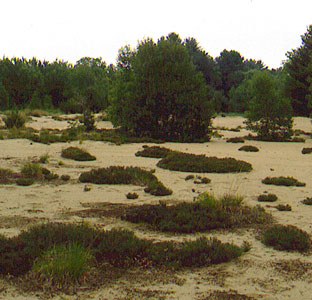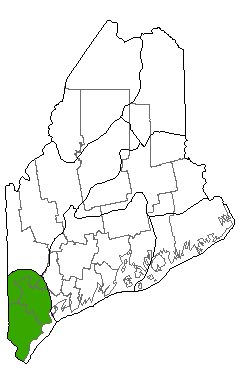DACF Home → Bureaus & Programs → Maine Natural Areas Program → Communities, Plants, and Animals → Natural Community Fact Sheets → Riverwash Sand Barren
Printer Friendly Fact Sheet - 770 KB pdf (Get a free copy of Adobe Acrobat Reader)
Riverwash Sand Barren
Scientific Name: Hudsonia River Beach; State Rank: S1

- Community Description
- Soil and Site Characteristics
- Diagnostics
- Similar Types
- Conservation, Wildlife and Management Considerations
- Distribution
- Characteristic Plants
- Associated Rare Plants
- Associated Rare Animals
- Examples on Conservation Lands You Can Visit
Community Description: These riverside barrens support dwarf shrub - graminoid vegetation dominated by little bluestem and other grasses, with beach heather in patches. Big bluestem is characteristic, as are pinweed and goldenrod species. Small white pine may be scattered throughout. The vegetation is patchy, with blowouts and other areas of bare sand or gravel. Some occurrences also support populations of the rare silverling. Although individual plants shift over time as their substrates are reworked by floods, the overall composition of the community does not change appreciably over the short term (10-20 years). Back to top.
Soil and Site Characteristics: Sites occur on gravelly or sandy barrens along river beaches and back beach areas where periodic flooding and xeric soils produce a distinctive disturbance regime. Most are in the two-year floodplain. Soils are very nutrient poor. Back to top.
Diagnostics: Sites occur on sandy floodplains with tree cover less than 25%. Little bluestem is prominent in the herb layer, and beach heather is present and locally dominant. Back to top.
Similar Types: This type is quite distinct. Little Bluestem - Blueberry Sandplain Grasslands share some species with this type, but are on flat outwash plains, not in rivercourses. Back to top.
Conservation, Wildlife and Management Considerations: All occurrences in Maine are on or adjacent to private land. Heavy recreational use on the Saco River poses a threat to some occurrences, which can be attractive picnicking or camping spots. Although this is a disturbance-adapted community, the impacts of ATVs and heavy foot traffic can be more concentrated and ecologically different from the natural flooding. Because of the dynamic riparian environment required by this community, conservation entails protection of the entire floodplain on particular segments of the river where these communities occur. Back to top.
Distribution: Known only from the Saco River in southern Maine and adjacent New Hampshire. Landscape Pattern: Small Patch. Back to top.


Characteristic Plants: These plants are frequently found in this community type. Those with an asterisk are often diagnostic of this community.
- Sapling/shrub
- Pitch pine
- Red Oak
- White pine
- Dwarf Shrub
- Beach heather*
- Herb
- Big bluestem
- Early goldenrod
- Flat-topped goldenrod
- Gray goldenrod
- Jointweed
- Little bluestem*
- Pinweed
- Poverty oatgrass
- Rand's goldenrod
- Silverling
- Silverrod
- Wooly panic-grass
- Bryoid
- Awned hair-cap moss
- Reindeer lichen
There are no documented rare animals associated with this natural community.
Examples on Conservation Lands You Can Visit
There are no documented examples on conservation lands that you can visit associated with this natural community.